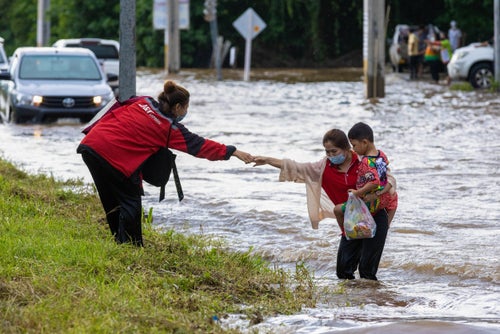

Everyone will be negatively impacted by climate change, but women and girls are expected to struggle to a much greater extent.
The topic was touched on during COP26′s Gender Day on Tuesday when the summit’s president, Alok Sharma, said: “We know that women and girls are disproportionately impacted by climate change.
“And we cannot allow equality to be a casualty of climate.”
But just why is climate change gendered – and what can be done about it?
Why are women and girls around the world especially susceptible to global warming?
In developing countries, women are usually responsible for gathering and producing food, collecting water and cooking. They are also primary caregivers.
All of these tasks become much harder when global warming hits, as extreme weather makes resources scarce.
IUCN – the International Union for Conservation of Nature – claims 70% of the world’s poorest people are women.
This became clear when, after the devastation of 2005′s Hurricane Katrina, African-American women were among the worst affected by flooding in Louisiana.
UN figures also shows that 80% of those displaced by climate change are women.
Girls are more likely to miss out on school when economies inevitably suffer during climate disasters, leading to an increase in domestic violence and child marriages.
Hindou Oumarou Ibrahim of the Association of Indigenous Women and People of Chad told the BBC: “In the dry season, men go to the towns...leaving women to look after the community.
″[women] become more vulnerable...it’s very hard work.”
Why are women in the global south expected to struggle the most?
Helen Pankhurst of CARE International told The Metro women from the global south “are carrying the heaviest burden of climate change”.
Poverty in the global south means people are more vulnerable to the climate crisis, despite producing the least amount of CO2 emissions. Countries such as Burundi, Congo, Mali, Chad, Malawi and Rawnda all produce less than one ton of CO2 emissions per capita a year, according to the Christian Aid Climate and Food Vulnerability Index.
Poorer nations will bear the brunt of the climate crisis because their populations have greater food insecurity, and rely on small-scale agriculture. A drought or a flood could therefore wipe out their food supply.
Women in the global south have been dealt the shortest straw when it comes to dealing with climate change.
Is this reflected in the world’s decision-making processes on global warming?
The 2015 Paris Agreement made specific provisions for women and acknowledged women are disproportionately impacted. Further promises have been made at COP26 to reduce gender inequality.
But UN Women claims 67% of decision-making roles about climate change around the world are still occupied by men – most of whom are white.
Pankhurst also pointed out that women from the global south “are marginalised from negotiations” at COP26 this year, “especially as the pandemic has limited participation of so many” due to vaccine inequity.
IUCN is just one of many organisations which has called for more women to be involved in the decision-making process, and claims that this would help speed up attempts to address the climate crisis.
The organisation said: “Women have the knowledge and understanding of what is needed to adapt to changing environmental conditions and to come up with practical solutions.”
“But they are still a largely untapped resource,” it concluded.
Did COP26′s Gender Day change anything?
The UK announced it would put £165 million towards supporting gender equality, and put women and girls at the centre of the solutions to the crisis.
Some £45 million of this is going to local communities and women’s groups in Asia and the Pacific, two areas set to be hit hard by the climate crisis, with the remaining £120 million going to “build resilience” and support “women’s leadership” in Bangladesh.
But Francesca Rhodes, senior advocacy and policy adviser at CARE International UK, said while this move was welcomed, “there is still a long way to go to ensure all climate finance and policies support gender equality”.
She added that the climate finance should reach women and girls most affected by floods, droughts and extreme weather.
The UK was not the only country to make a gender-specific pledge.
Bolivia, Canada, Ecuador, Germany, Nigeria, Sweden and the US all promise to strengthen the leadership of women and girls in one or another, with some countries promising to invest more money in gender equality solutions.
However, critics were quick to point out that the pledges all missed out any mention of sexual and reproductive health rights.
This is a pressing concern in a climate crisis when gender-based violence increases and resources are scarce.
Dr Heather McMullen from Queen Mary University of London’s Institute of Population Health Sciences pointed out at COP26 that “people need control over their bodies to respond and adapt to climate change”.